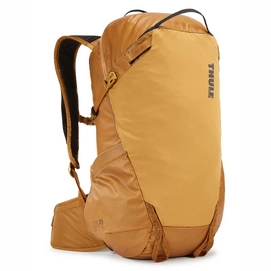Best Backpacks
Which size backpack?
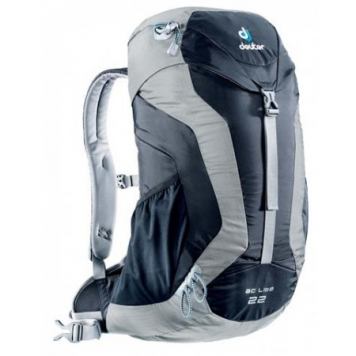
Backpack 20-30 L
1-2 days
A backpack of 20 to 30 litres is ideal for people who are only going away for a couple of days and will be doing activities such as walking and cycling. A small backpack is preferred above a normal daypack, or rucksack, as it is often more durable and provides more comfort. A small backpack can also be used as a daypack while a larger backpack can be used for a longer journey.
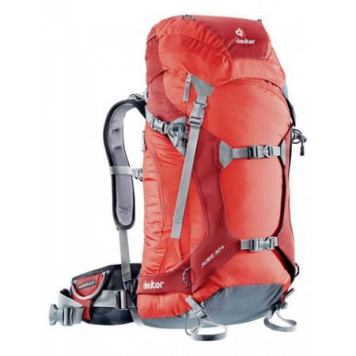
Backpack 30-50 L
1-7 days
A backpack of 30 to 50 litres is suitable for multi-day trips that last up to about a week. This type of bag is ideal to keep active on a holiday or a short break. A backpack with such this capacity range is compact, easily adjustable, and provides sufficient comfort to travel smoothly. When you choose a backpack with a capacity of 30 to 50 litres, you are able to take a fair amount of clothing and you will have enough room for other necessary accessories.
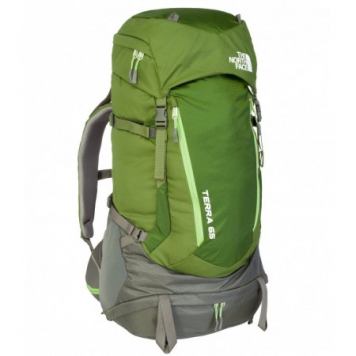
Backpack > 50 L
7+ days
Are you planning to take a longer trip or go backpacking for an extended period of time? Choose a backpack with a minimum capacity of 50 litres. This is ideal for several weeks of clothing and to carry items that you may need for your specific destination. Due to the fact that you are often on the road or travelling through unknown areas, a backpack is more comfortable and convenient than a suitcase or travel bag.
Choose the right capacity and content
Where are you going?
The capacity size of our backpacks is displayed in litres. A large backpack is needed for a long backpacking trip where you have to deal with different climates and weather conditions. Extra space for a sleeping bag or warm clothes are accounted for in this way.
On an extended holiday or trip, you often require a large backpack. We advise you to choose a backpack with a minimum capacity of 50-60 litres so you can pack enough to travel for several weeks. Given the warm climate in these areas, you may choose to take less(and lighter) clothing in a backpack with a smaller capacity. This way, you spare your shoulders and back. We nevertheless recommend to travel to warm places with a backpack with a decent capacity limit.
What should you bring?
The contents of a backpack is one of the most important aspects to consider. Begin by thinking carefully what you will need during your trip. Travelling to a cold destination will require a lot of warm clothes, while the opposite will be needed for a tropical destination. Keep in mind that there is a big difference in volume between these two choices as warm clothing occupies more volume then lighter clothing.
Accommodation
Will you be staying in hotels and hostels, or is camping also in the schedule? In the latter case, you should take into account additional space for camping gear such as a sleeping bag, sleeping mat, and even a tent. You may also have to leave space for cooking accessories such as a stove, thermos, or cutlery.
What will you do exactly?
During your trip will you be climbing a mountain or hiking through dense forest? Take into account that some backpacks have many loops, strings, and other protruding parts. These can be dangerous during some outdoor activities. Outdoorsupply recommends to purchase a backpack without these parts if you are planning a more active trip.
If you go camping during your trip, it is useful to have multiple loops, strings, and other parts are your disposal. For example, you can attach a sleeping bag, sleeping mat, or a mosquito net to your backpack.
Packing your Backpack
Packing your backpack
A common mistake that many people make when looking for a backpack is focusing on the design, the extra features, and the price. While these are all important, the most valuable aspect to consider is comfort. Make sure you purchase a backpack that fits perfectly to your body.
Of the total weight of your luggage, about 70%-80% should be fixed on the hips. This weight prevents incorrect posture and pain in the shoulders and the back. It is important that the backpack fits you well.
As shown in the figure on the left, it is recommended to place the heaviest luggage close to the back. A rolled up sleeping mat or sleeping bag can be placed under here. The heaviest baggage such as a tent, shoes, clothes, and heavy cookware must be stored closest as possible to the back. In the middle section above the sleeping bag you should store the rest of your clothing, lighter cooking utensils, and toiletries. Lighter items, including accessories like a torch, pocket knife, drinking thermos, camera, or phone, should be stored at the top of the backpack. In the zippered compartments, important things like a passport, wallet, money and other valuables can be kept.
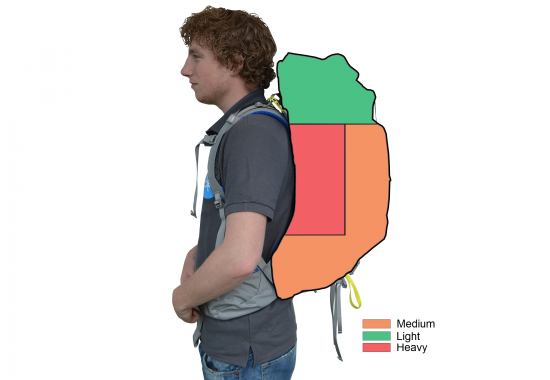
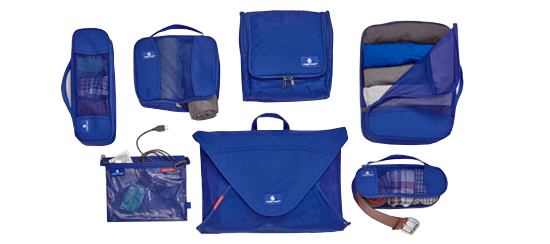
Optimise your packing
If you have a hard time packing your luggage and experience stress while doing it, the Pack-It System by Eagle Creek is definitely something for you. All items in this collection are an additional tool to pack in your backpack, that are designed to help make packing as straightforward as possible. This way you will quickly be able to get to what you need during your holiday, but also keep your things packed in an organised way. Click here to view our collection of Pack-It Systems.
Backpacks for men & women
Backpacks for men
There are no special backpacks for men because a man of a normal size will fit most kinds of backpack. Some backpacks we offer do. however, come in different sizes. If you are very tall, then you must take this into account and find a backpack that will provide an adjustable back length.
If you are a small or have a more narrow figure, then a backpack with narrower shoulder straps and a shorter back panel will be ideal. The back length is slightly adjustable in any backpack as well as the shoulder straps, so this provides most men with a wide range of suitable backpacks.
Backpacks for women
Although most backpacks are unisex, there are special backpacks for women and smaller men. Due to the average man having a longer back and broader shoulders than the average woman, special backpacks have been made for women by some brands. These backpacks made specifically for women have shorter and narrower shoulder straps. It is also possible to choose a woman's backpack for a smaller man. By opting for a narrower backpack with a shorter carrying system, the wearing comfort will improve significantly. Conversely, it is also possible to choose a longer and wider unisex backpack.
What is your back length?
Determining the right back length
To make sure you choose the right backpack for your body, you can measure your back length. It is advisable to measure your back without shoes on and with minimal (above) clothing. The back length is measured vertically from the top of your neck, at the height of your shoulders to the bottom of your torso.
It is advised to ask someone else to measure your back length so that is can be as accurate as possible. Make sure that the tape measure is placed firmed against your back and towards the hips. On your hips the hip strap will rest here and carry the heaviest luggage. The distance from your neck to your shoulders then your hips is your back length. When you have calculated your back length, you will know exactly which backpacks are suitable for you.
If you have a back length of shorter than 40 cm you will require a relatively small backpack. A medium back length is from 40 to 45 cm and a large backpack requires a back length of more then 45 cm.
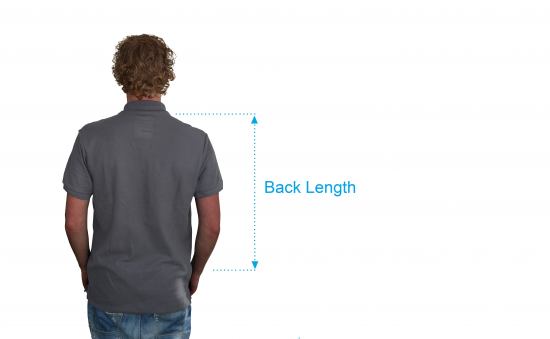
Do you have a preference for a particular brand?

Black Diamond
Black Diamond has more than 50 years of experience in the outdoor world. The backpacks made by this brand offer modern and innovative designs that embrace backpackers, mountaineers, and athletes.

The North Face
The North Face delivers beautiful, stylish designs and has years of experience in the outdoor market. A backpack made by The North Face can promise high quality with a trendy look.

Eagle Creek
Eagle Creek has a wealth of experience in designing backpacks and organisation systems. Their Pack-It System is a revolutionary system that keeps your clothes organised and allows you to pack more.

Deuter
This quality brand has a collection of backpacks in different colours, sizes, and designs. Deuter is know for their excellent price / performance ratio, so you know you can't go wrong with a Deuter backpack.
Our Advice

Day trips
If you only have a few days off and want to buy a backpack for weekend away, or a hike, or a day of cycling, then a day bag is what you are looking for. You won't need a lot of room for baggage, but if you want to be able to bring extra clothes and a lunchbox, then a backpack with a capacity of 20 to 30 litres is best for you.
These backpacks will give you extra comfort on the shoulders and back while allowing you to bring all the necessary things you might need. For a cycling trip or short hike, then we would recommend something nearer 20 litres than 30.

Activity based trip
If you are planning a trip in which you will be very active, then you are looking for a backpack that can carry at least a weeks worth of clothes. For example if you are going to camp, or attend a multi-day festival then the backpack should not be too small or uncomfortable.
We recommend choosing a backpack with a capacity of 20 to 50 litres. Remember, a heavy backpack is not good when hiking, cycling, or doing other physical activities. Choose your bag carefully and only pack things that will absolutely need.
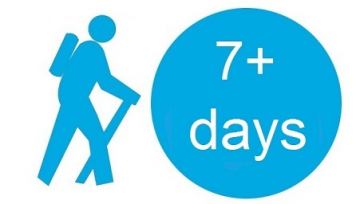
Long journey
If you are backpacking or travelling around distant destinations, then we advise that you choose a backpack with a minimum capacity of 50 litres. To make sure that you can hold enough luggage to travel for several weeks, it is advisable to choose a backpack that meets this requirement.
A backpack of 50 litres or more can easily fit over 10 t-shirts, 3-4 jumpers, and 4-6 trousers, or whatever else you might want to pack. Consider that you may additional pairs of shoes, underwear, socks, or swimsuits.

